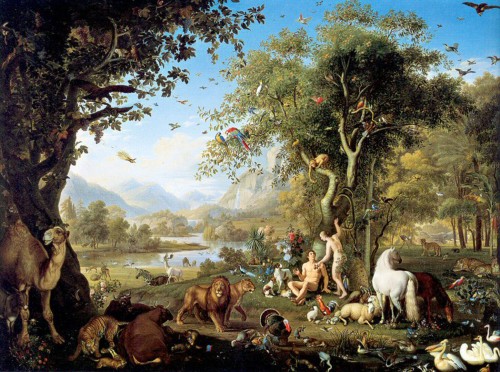
I am the good shepherd: the good shepherd giveth his life for the sheep. (John 10:11)
In the last “I AM” statement, Jesus said He was “the door” – the only way into the sheepfold. We also learned that a porter guarded the door by physically placing himself across the entrance (John 10:3). In essence, the porter became “the door.” In the absence of a porter, the shepherd himself would perform this task making himself the door (John 10:9).
Now Jesus identifies Himself as the “Good Shepherd.” Previously, Jesus pointed out some general characteristics of a shepherd. The shepherd has rightful access to the sheep (John 10:2) because they belong to him. The shepherd knows each of his sheep by name, and the sheep know the voice of the shepherd, and they follow him as he leads them (John 10:3-4).
As the Good Shepherd, Jesus is also the Door of the sheepfold. The word picture presented here provides greater insight into His task as the Good Shepherd. As a shepherd cares for his sheep, he defends them with his very life. Any predator seeking to harm the sheep will do so only over the shepherd’s dead body. Jesus’ hearers may have recalled the account of King David:
And David said unto Saul, Thy servant kept his father’s sheep, and there came a lion, and a bear, and took a lamb out of the flock: And I went out after him, and smote him, and delivered it out of his mouth: and when he arose against me, I caught him by his beard, and smote him, and slew him. Thy servant slew both the lion and the bear: and this uncircumcised Philistine shall be as one of them, seeing he hath defied the armies of the living God. (1 Samuel 17:34-36)
Likewise, Jesus says, “the good shepherd giveth his life for the sheep” (John 10:11).
On the contrary, a hired hand has nothing invested in the sheep. When danger arises, he runs for his life caring nothing for the sheep (John 10:12-13). The Good Shepherd defends the sheep with His life because He cares for His sheep, knowing each one by name (John 10:14). As in verse 3, this assertion emphasizes the relationship between the Good Shepherd and His sheep. Indeed, it is likened to the relationship between the Father and the Son. “As the Father knoweth me, even so know I the Father: and I lay down my life for the sheep” (John 10:15).
By now the reader should recognize that “sheep” are analogous to God’s people. “For thus saith the Lord GOD; Behold, I, even I, will both search my sheep, and seek them out. As a shepherd seeketh out his flock in the day that he is among his sheep that are scattered; so will I seek out my sheep, and will deliver them out of all places where they have been scattered in the cloudy and dark day” (Ezekiel 34:11-12, emphasis mine). On another occasion, Jesus said:
What man of you, having an hundred sheep, if he lose one of them, doth not leave the ninety and nine in the wilderness, and go after that which is lost, until he find it? And when he hath found it, he layeth it on his shoulders, rejoicing. And when he cometh home, he calleth together his friends and neighbours, saying unto them, Rejoice with me; for I have found my sheep which was lost. I say unto you, that likewise joy shall be in heaven over one sinner that repenteth, more than over ninety and nine just persons, which need no repentance. (Luke 15:4-7, emphasis mine)
The Good Shepherd gives up His life for His sheep.
Jesus addressed a Jewish audience who readily identified themselves with the Good Shepherd’s sheep, but then Jesus added another twist. “And other sheep I have, which are not of this fold: them also I must bring, and they shall hear my voice; and there shall be one fold, and one shepherd” (John 10:16, emphasis mine). This must have confused Jesus’ hearers, but in retrospect, we understand that Jesus referred to the Gentile Christians that would be included later, after His resurrection and ascension. “They” would hear His voice through the work of the Holy Spirit and the preaching of the Apostles (John 15:26; 17:20-21).
For all of these the Good Shepherd gave up His life. All those within His fold can confidently say:
The LORD is my shepherd; I shall not want.
He maketh me to lie down in green pastures: he leadeth me beside the still waters.
He restoreth my soul: he leadeth me in the paths of righteousness for his name’s sake.
Yea, though I walk through the valley of the shadow of death, I will fear no evil: for thou art with me; thy rod and thy staff they comfort me.
Thou preparest a table before me in the presence of mine enemies: thou anointest my head with oil; my cup runneth over.
Surely goodness and mercy shall follow me all the days of my life: and I will dwell in the house of the LORD for ever. (Psalm 23:1-6)
There is security in the Good Shepherd’s fold.
My sheep hear my voice, and I know them, and they follow me: And I give unto them eternal life; and they shall never perish, neither shall any man pluck them out of my hand. My Father, which gave them me, is greater than all; and no man is able to pluck them out of my Father’s hand. (John 10:27-29, emphasis mine)
Then, just in case the “I AM” statement was not clear enough, Jesus said, “I and my Father are one” (John 10:30). Jesus declared Himself equal to God. Indeed, He is God (John 1:1) To the Pharisees (and to many modern ears) such a claim was blasphemous. “Then the Jews took up stones again to stone him” (John 10:31). “This parable spake Jesus unto them: but they understood not what things they were which he spake unto them” (John 10:6). Not included in the Good Shepherd’s fold, they remained in their blindness (John 9:39-41), and failed to recognized that they were in the presence of the Great I AM, the Good Shepherd.
If you want entrance into the fold, you need to get to know the Good Shepherd.



